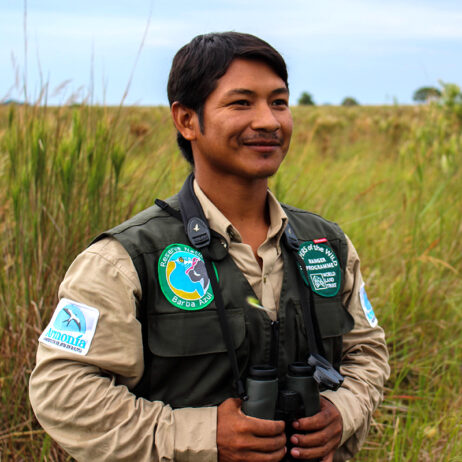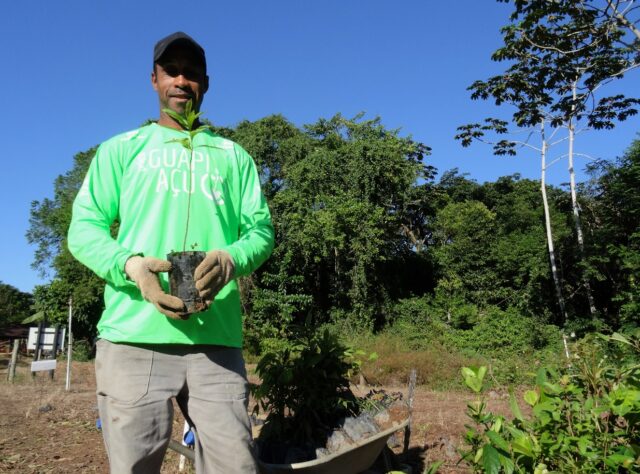
Mauricio Noqueira, ‘o pai das florestas plantadas’ – ‘father of the planted forests’, holds one of the half a million saplings which have passed through his hands at REGUA, Brazil. Image credit: © Micaela Locke
By Lee Dingain – UK representative for REGUA.
Mauricio Noqueira has been head of the nursery at the Guapiaçu Ecological Reserve (REGUA) in Brazil’s Atlantic Forest for 15 years. Almost all the half a million plus saplings planted at REGUA have passed through Mauricio’s hands, and we are proud to call him ‘o pai das florestas plantadas’, father of the planted forests.
The Atlantic Forest is one of the world’s top biodiversity hotspots. Containing a richer biodiversity than most of the Amazon rainforest and extremely high levels of endemism, the second-largest rainforest in South America stretches along the Atlantic coast from Rio Grande do Norte in Brazil, to north-east Argentina. But the Atlantic Forest is also highly threatened. Five centuries of devastating habitat loss have left little of the forest intact. Estimates range from 16 down to just seven per cent remains, and much of this is fragmented.
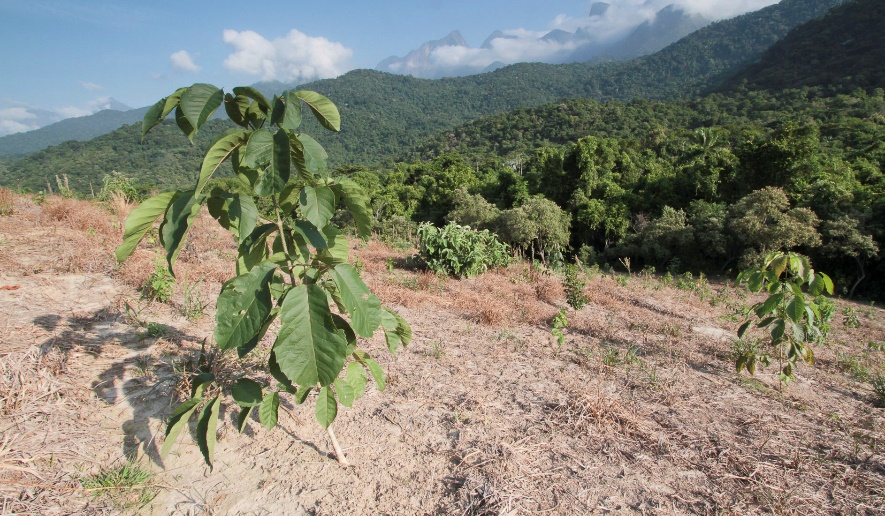
REGUA has planted over half a million saplings since 2004, reconnecting isolated forest fragments and reforesting 384 hectares of degraded land in the Guapiaçu valley. Image credit: ©Barry Yates.
The upper Guapiaçu valley, where REGUA is located, is fortunate in retaining extensive forest cover on the steep mountain slopes, as well as small forest fragments on the valley floor. One of our goals at REGUA is to restore as much forest as we can, and where possible reconnect isolated forest fragments to the main forest block.
The reforestation programme began in 2001, with the first trees planted in 2004. Since then REGUA has reforested 348 hectares and planted 557,119 trees; 300,000 planted since 2013 in partnership with the Petrobras-funded Guapiaçu Project. REGUA’s nursery was built in 2005 and gradually expanding to accommodate around 20,000 saplings a year. Then after outgrowing its location, in 2012 it was moved to a much larger site next to the reserve entrance.
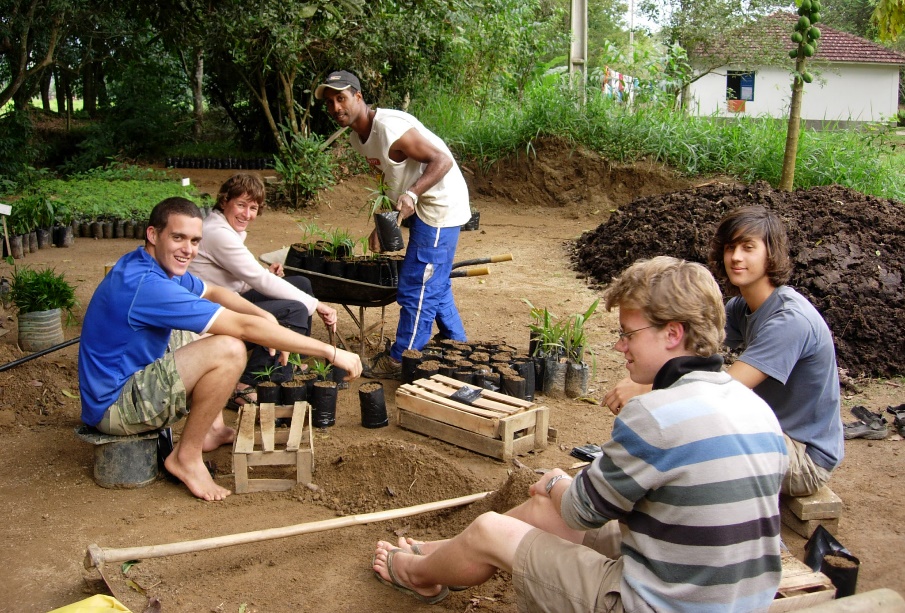
Mauricio at the first nursery a year into his role, assisted by REGUA’s first international volunteers. Image credit: ©Lee Dingain.
Growing up in the village of Guapiaçu, Mauricio da Canceição Nogueira wanted to be a truck driver and see the rest of Brazil. But in 2001 he became one of REGUA’s first employees and accepted a position as a forest ranger. After three immensely enjoyable years, during which he and his colleague Rildo da Rosa Oliveira opened the first trails in the forest and made the first sighting at REGUA of the Critically endangered Southern Muriqui (Brachyteles arachnoides), he applied for the role of REGUA gardener. Along with maintaining the lodge garden and grounds around the conservation centre, Mauricio started collecting seeds and producing saplings for the reforestation programme, with great success. As more areas of land became available for REGUA to reforest, his nursery duties increased.
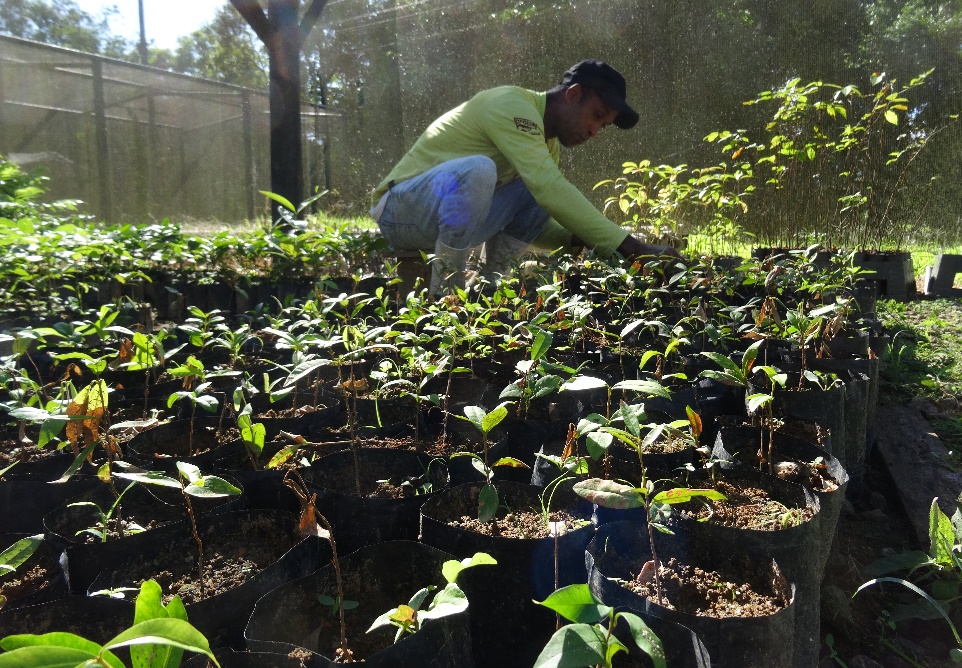
Mauricio tending seedlings in the nursery, which today produces up to 70,000 saplings a year for reforestation at REGUA. Image credit: ©Micaela Locke.
Eager to improve his skills and specialise in reforestation, Mauricio decided on some formal training. Attending several courses, he gained valuable insight into seed collecting, germination, production and quality of seedlings, the most important species for reforestation, and learned the scientific names of trees. With his success in nurturing seedlings well-proven and his formal training complete, Mauricio took on the position of head of the REGUA nursery in 2005 and is today responsible for producing up to 60,000 saplings each year.

In the hot climate at REGUA, seedlings need watering twice a day, a time-consuming task when you might have 60,000 of them! Image credit: ©Micaela Locke
Up to 180 native tree species are grown in the nursery, with 50-60 produced most years. The majority are pioneer species, those short-lived shade-intolerant early colonisers such as Araribá-rosa (Centrolobium tomentosum) and Alligator Stick (Piptadenia gonoacantha), and secondary such as Brazilian Cedarwood (Cedrela fissilis). But some climax species, characteristic of mature forest, are also grown, including giant emergents like the Pink Jequitibá (Cariniana legalis), the tallest tree in the Atlantic Forest. Planting a mixture of pioneer, secondary and climax species increases species diversity in the reforested areas and boosts natural succession. Although the quick-growing pioneers race upwards at 1.5-2 metres a year, the seedlings of the slower-growing secondary and climax species are longer-lived and easily outcompete the pioneers in the shady understorey, eventually dominating as the canopy becomes denser.
Most of the saplings are grown from seeds collected locally from the forest by the rangers and Mauricio, who maintains records of matrix trees, those trees whose seeds produce quality saplings, including GPS coordinates and when they produce seeds. Some seeds are collected from the ground, but after attending a tree climbing course at the Three Peaks State Park, Mauricio now collects many from the canopy, especially seeds that are dispersed by wind; hazardous work that involves carrying 20 kilograms of equipment into the forest.

Tree planting at REGUA is timed to coincide with the rainy season of the austral summer, the regular rains vital for the saplings to become well established. Image credit: ©Alan Martin.
Once germinated, the seedlings are transplanted to grow bags where they develop into saplings. Mauricio waters them twice a day and weeding is a never-ending task, especially tiring during the summer rainy season when growth rates soar. Some, like the Brauna Melanoxylom brauna, a valuable hardwood endemic to the Atlantic Forest, are difficult to grow, but he loves seeing the trees develop and feels a great sense of pride knowing that all his effort has been worth it.

Planting out requires a huge team effort and is physically demanding work in often steep terrain. Image credit: ©Nicholas Locke.
Planting out the saplings requires a huge team effort. Each year during the rainy season, the saplings are transported by truck and mule to specially prepared planting areas, often on very steep slopes. It is physically demanding work, at the hottest time of year, but the regular summer rains are vital if the saplings are to become well established. Aftercare is also essential. Leafcutter ants can very quickly strip a saplings foliage before it becomes established, and weeding is required, along with watering during periods of drought. But thanks to the quality of saplings produced and regular maintenance after planting, REGUA achieves an impressive 95 per cent survival rate.
Integral to this success is Mauricio’s colleague Aline Damasceno. Currently a Forest Engineer for the Guapiaçu Project at REGUA, Aline works very closely with Mauricio and has been his mentor for many years. Her knowledge, experience and guidance are invaluable, and Aline has been instrumental in improvements to the nursery infrastructure and obtaining grants for reforestation. To encourage others to replicate REGUA’s reforestation success, Aline and Mauricio have also provided training on seed collection and seedling production.
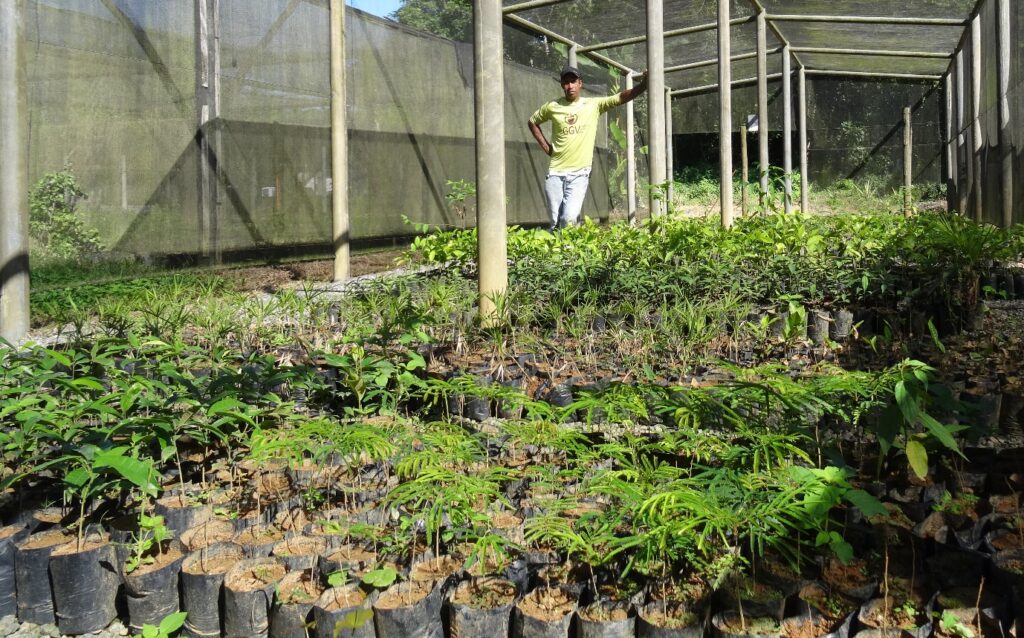
Mauricio in a section of the tree nursery at REGUA, Brazil. Image credit: ©Micaela Locke.
Mauricio is very proud of his work and thrilled with the recognition he receives as head of the nursery. And with REGUA keen to buy and reforest more land in the Guapiaçu valley, long may Mauricio continue.


